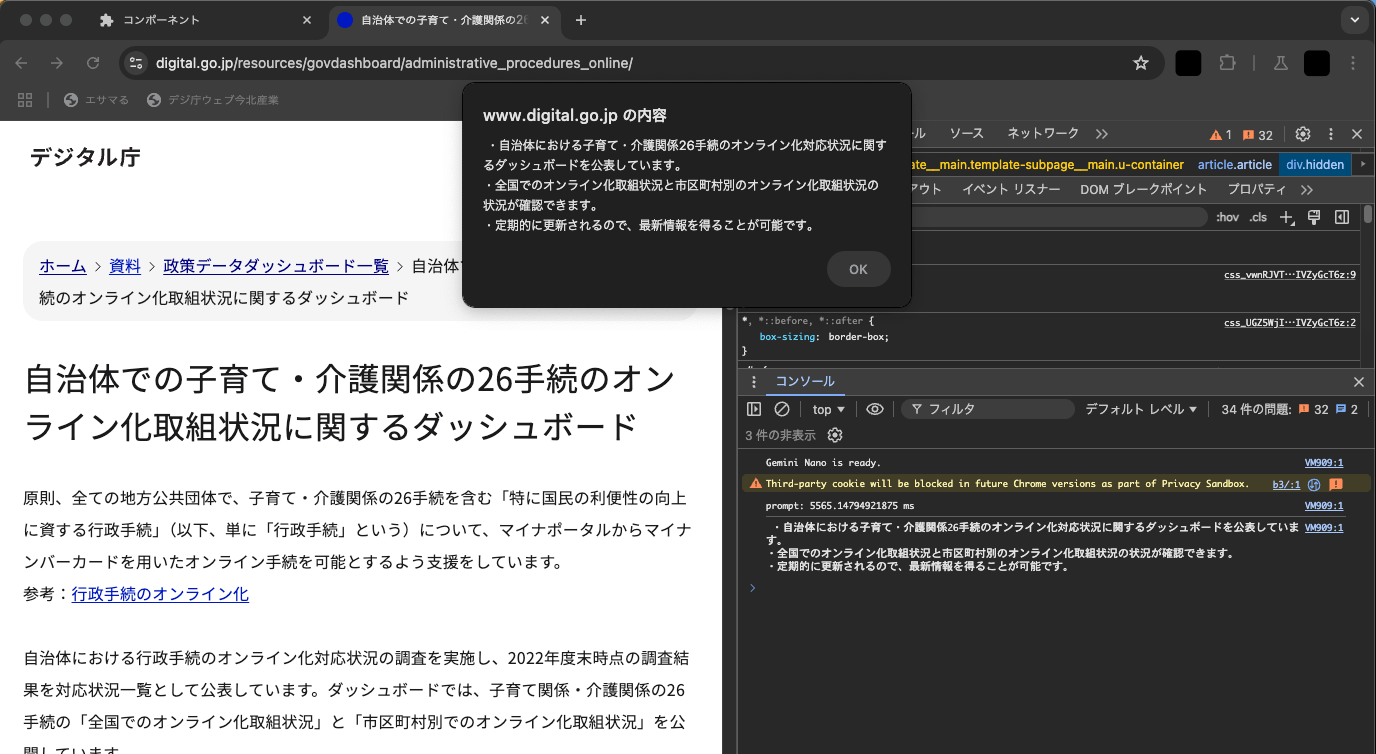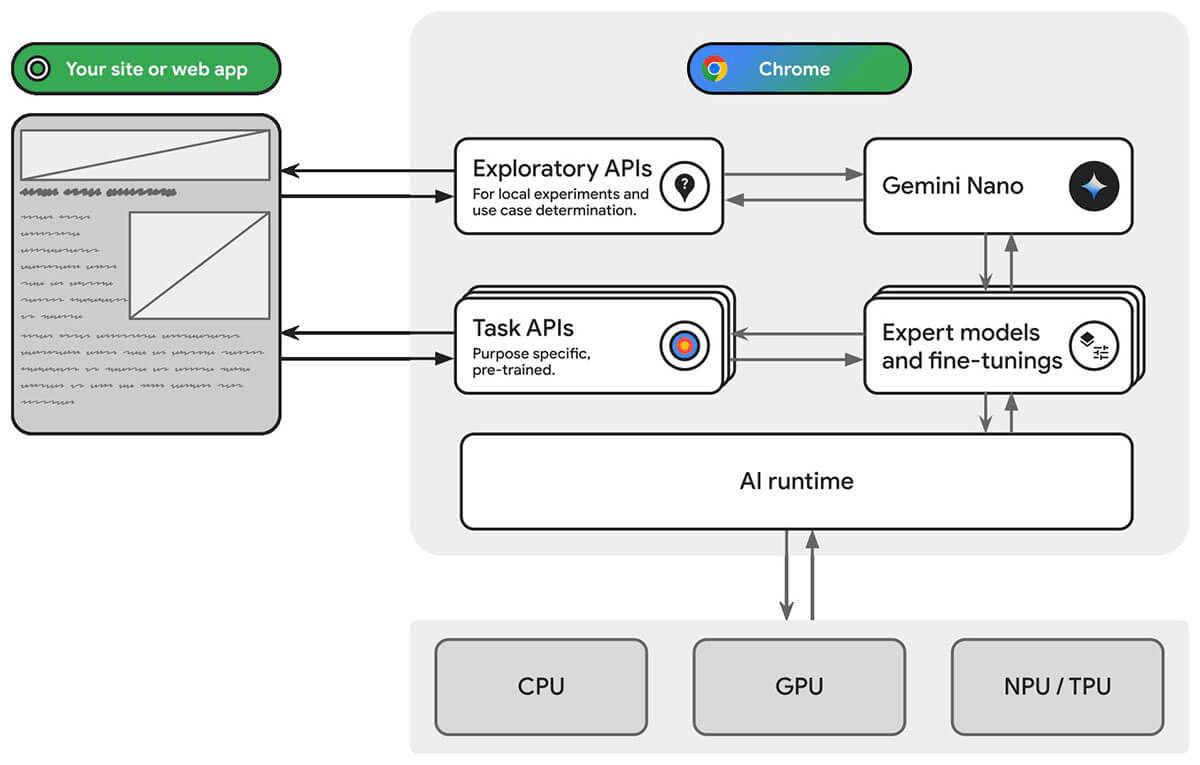Chrome Dev Channel で Gemini Nano をオンデバイス LLM として試す
Chrome の次のバージョンにオンデバイスLLMとして Gemini Nano がインクルードされることが検討されているらしい。 Chrome Dev Channel で既に試せる。
Gemini Nano
Googleが開発する生成AIモデル「Gemini」ファミリーの1つ。特にオンデバイスでのタスクに最適化された小型モデル。小型ですがマルチモーダルに対応しており画像や音声などを処理可能です。既に Pixel 8/8a や Samsung Galaxy S24 などの特定のスマホへの統合が進んでいます。
- GoogleがPixel 8とPixel 8aにも生成AI「Gemini Nano」を追加、外部ディスプレイへのサポートやPixel Watch 2での自動車衝突検出なども発表 - GIGAZINE
- Samsungの「Galaxy S24」、Googleの「Gemini」で高度なAI機能満載 - ITmedia NEWS
Chrome Dev Channel
Chrome ブラウザには、Stable、Extended Stable、Beta、Dev、Canary の 5 つのチャンネルがあり、Dev はいち早く新機能を試せる。
Dev チャンネルの機能は完全に安定しているわけではありません。デベロッパーは Dev チャンネルを使用して Chrome の新機能をプレビューできます(Stable 版より 9~12 週間早くプレビュー可能)。
利用するための手順はざっくり次のとおり
- Chrome の Dev Channel をPCにインストールする。
- 次の2つの flags を変更し、1つの component をアップデート。
-
chrome://flags/#optimization-guide-on-device-model:-
Default→Enabled BypassPerfRequirement
-
-
chrome://flags/#prompt-api-for-gemini-nano:-
Default→Enabled
-
-
chrome://componentsのOptimization Guide On Device Model-
アップデートを確認。自分のてもとではバージョン: 2024.6.5.2205になった。
-
-
「Optimization Guide On Device Model」が当初表示されなくて???。しかし Chrome Dev を再起動したりお茶を飲んだりしてたらいつの間にか表示されるようになっていた。表示されない方いたら試してみてください。
Enabled BypassPerfRequirement とは?
Enabled bypass performance requirement の略だと思う。性能要件はとりあえず無視して有効化する、ということ。小型モデルとはいえ LLM なのでPCのCPU/GPUなどの性能次第ではまともに使えなかったり場合によっては悪影響があるおそれもあるんだろうけどとりあえず評価したいという場合に、くらいで理解した。
参考
esa の記事を要約してくれるコードを書いてみた。
(async () => {
if ((await window.ai.canCreateTextSession()) === "readily") {
console.log("Gemini Nano is ready.");
const postText = document.querySelector("div.post-body").innerText;
console.time("prompt");
const session = await window.ai.createTextSession();
const result = await session.prompt(`次の文章を3行に要約してください。\n\n----\n\n${postText}`);
console.timeEnd("prompt");
console.log(result);
window.alert(result);
} else {
console.log("Gemini Nano is NOT ready.");
}
})();
ブックマークレット(ブックマークに保存するとクリックで実行できる JS)にするとこう↓。
javascript: (async () => { if ((await window.ai.canCreateTextSession()) === "readily") { console.log("Gemini Nano is ready."); const postText = document.querySelector("div.post-body").innerText; console.time("prompt"); const session = await window.ai.createTextSession(); const result = await session.prompt(`次の文章を3行に要約してください。\n\n----\n\n${postText}`); console.timeEnd("prompt"); console.log(result); window.alert(result); } else { console.log("Gemini Nano is NOT ready."); } })();
記事の量次第でも大きく変わるが、レイテンシは数秒から場合によっては30秒以上。 NW 通信はないわけだが、やはりけっこう処理時間がかかる。 M1 MacBook Air だからかもしれない。
ついでにデジタル庁の各記事を要約してくれるコードも書いてみた。記事の内容を取ってくるdocument.querySelector/querySelectorAll 以外さっきとまったく同じ。
コード:
(async () => {
if ((await window.ai.canCreateTextSession()) === "readily") {
console.log("Gemini Nano is ready.");
const postText = document.querySelectorAll("article.article > div")[1].innerText;
console.time("prompt");
const session = await window.ai.createTextSession();
const result = await session.prompt(`次の文章を3行に要約してください。\n\n----\n\n${postText}`);
console.timeEnd("prompt");
console.log(result);
window.alert(result);
} else {
console.log("Gemini Nano is NOT ready.");
}
})();
上記のブックマークレット:
javascript:(async () => { if ((await window.ai.canCreateTextSession()) === "readily") { console.log("Gemini Nano is ready."); const postText = document.querySelectorAll("article.article > div")[1].innerText; console.time("prompt"); const session = await window.ai.createTextSession(); const result = await session.prompt(`次の文章を3行に要約してください。\n\n----\n\n${postText}`); console.timeEnd("prompt"); console.log(result); window.alert(result); } else { console.log("Gemini Nano is NOT ready."); } })();
生成された結果と処理時間:

こういった単なる要約はたぶん高レベル API の提供が充実してくると思うでもっと簡単になるだろう。
を読むと、
- Translation API
- Summarization API
- ファインチューニング(LoRA)API
などが示唆されている。
このアーキテクチャ図も夢が膨らむ。
